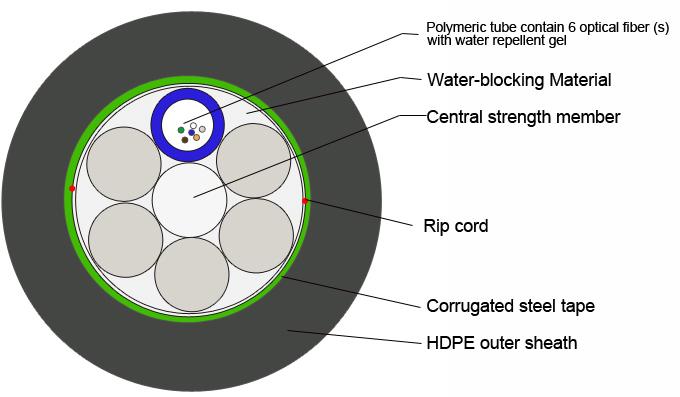- Related articles
- Optical Transceivers for Cisco WS-C2960+48PST-S Switch
- Optical Transceivers for Cisco WS-C3750G-24PS-S Switch
- EOL Cisco Switch WS-C2960S-48FPS-L Replaced with WS-C2960X-48FPS-L
- Things you need to know about integrated network card
- The Difference between SATA, PCIe and NVMe
- Optical Transceivers for Cisco IE-2000-4TS-G-L Switch
- Optical Transceivers for Cisco N7K-M206FQ-23L= Switch
- What is SFP fiber optic transceiver?
- All Cisco DWDM-SFP10G-30.33's information (List price, Specs, Datasheet PDF, Compatibility
- Optical Transceivers for Cisco WS-C2960C-8TC-L Switch

Definition of GYFTS Fiber Optic Cable
GYFTS Fiber Optic Cable is the type of fiber optic cable that is made up of the loose tube jell-filled structure. It has no metallic central part like many other types but it is self-supported. Consequently, it is laminated by a steel-polyethylene sheath. According to the research, GYFTS Fiber Optic Cable can function well under any temperature; both low and high temperatures. That outstanding feature gives it an upper hand over the other types.
Technical characteristics of GYFTS Fiber Optic Cable
Very strict material and manufacturing control guarantee the cable can work stably for more than 30 years.
Total cross-section water-resistant structure and PSP armor make cable have excellent properties of moisture resistance
Special jelly filled in the loose tube provides the fibers with critical protection
The central member adopted FRP has excellent tensile performance and flexible performance.
PSP armor structure has super crush resistance.
General Features of GYFTS Fiber Optic Cable
1. Full cross-section water-blocking structure and longitudinal armor with both side coated steel tape present reliable performance of moisture-proof and water block.
2. The loose tube is filled with special factice for the key protection of fiber.
3. High-modulus glass fiber reinforced plastics (FRP) central strength member.
4. Product life is 30 years

Applications of GYFTS Fiber Optic Cable
GYFTS Fiber Cable is suitable for long-distance communication and interoffice communication.
Way of Laying: Overhead, Pipeline.
Adopted to Outdoor distribution
Suitable for aerial & pipeline laying method
Long distance and local area network communication
Usable in Duct or Aerial
Long-haul communication system
Junction communication system
Subscriber network systems
Local area network systems
Operating temperature
Environmental Space Aerial, lashed | Buried
Installation Temperature 30°C to +70 °C (22°F to +158 °F)
Operating Temperature 40°C to +70 °C (40°F to +158 °F)
Storage Temperature 40°C to +75 °C (40°F to +167 °F)
Structure of GYFTS Fiber Optic Cable
|
Structure |
Unit |
Parameter |
|
|
Fiber count |
fibers |
24 |
48 |
|
Element |
-- |
5 |
5 |
|
Loose tube Diameter |
mm |
1.9/1.3 |
2.2/1.55 |
|
Cores of per tube(no more than) |
-- |
6 |
12 |
|
Phosphatic steel wire/PE sheath( if required) |
mm |
1.5 |
1.6 |
|
Cable diameter(Nom.) |
mm |
10.0 |
10.8 |
|
Weight(Approx.) |
Kg/km |
113 |
131 |

Performance
Max attenuation: 0.38dB @ 1310nm and 0.25dB/Km @1550nm
Fiber: G652D
Installation: Aerial or duct
Application: Apply to Long distance communication system, Local area network system
Lifetime: above 30 years
Operating temperature: -40°C~+70°C
Permission bent radius Static: 10 times O.D. Dynamic: 20 times O.D.
Conclusion
GYFTS Fiber Optic Cable is considered as one of the best and widely used types of fiber optic cable due to its unique features. It is characterized with durability and simplicity. Therefore, it can be used by anyone even without any technical knowledge.





















































